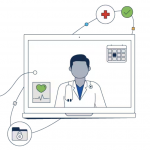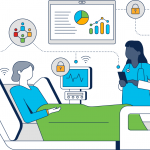As part of our National Health IT Week blog series, today we are looking at the role technology can play in accelerating the clinical workforce. A modern public health workforce is essential to harnessing the power of new technologies that promote better, faster health services. As we continue our evolution into a 21st-century health ecosystem, a robust and diverse workforce that includes engaged clinical and technical professionals is essential to realize the full potential of this transformation.
Doctors, nurses, and other clinicians get into healthcare to heal people. Technology’s role is to make their jobs easier, more effective, and more efficient – but that isn’t always how it works.
Technology can sometimes feel like it puts up barriers between patients and clinicians – like when the same patient’s medical information is typed into a tablet for what feels like the 100th time. And how integrating new technologies into workflows can feel like a burden for clinicians to learn and use.
 With fast access to specialists, time saved finding equipment, and real-time updates to health records, doctors and nurses can spend more time delivering the best care.
With fast access to specialists, time saved finding equipment, and real-time updates to health records, doctors and nurses can spend more time delivering the best care.
In order to take advantage of the promise of IoT and connected healthcare, a hospital needs a strong infrastructure. This means:
- Security – The ability to track the passage of information and identify early any vulnerabilities and attacks.
- Monitoring network traffic to identify unexpected patterns – quickly pointing to and allowing for remediation of security or capacity issues.
- Automation enables compliance with the latest security policies, frees up IT staff, and provides faster and more efficient services, so clinicians can focus on patients, not on if their technology is working properly.
- Network prioritization ensures non-critical services, like guest Wi-Fi, don’t dominate bandwidth to the detriment of care-related services, like EMR data processes.
- Network analytics provide an understanding of what is happening in the network – identifying bandwidth problems and enabling network prioritization.
To explore these opportunities and network solutions in more depth, Creative Intellect Consulting has developed a series of four papers – including one on streamlining clinical experiences in IoT and connected. Check back for the rest of our National Health IT Week blog series to learn more about IT strategies that can help:
Check back for the rest of our National Health IT Week blog series to learn more about IT strategies that can help:
- Expand access to broadband and telehealth
- Improve public health and population health
- Address social determinants of health
- Modernize health infrastructure


This is an interesting post, as both a pre-health student and an IoT and blockchain enthusiast. I wonder if and how blockchain could benefit the healthcare system. Great article!